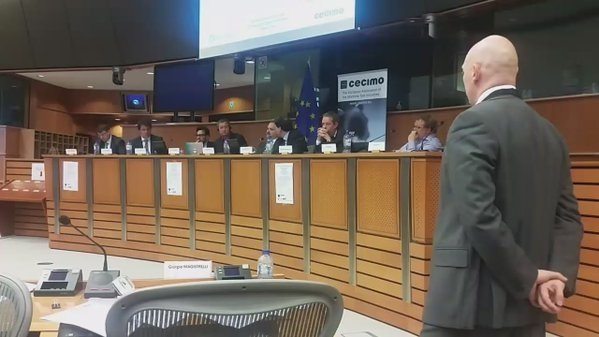Wednesday, the 25th of May 2016 was held the Additive Manufacturing and European Conference 2016 at the European Parliament. It was a great opportunity for the present representatives from companies, EU institutions, think tanks and other stakeholders of the machine tools sector to discuss the creation of a European strategy for additive manufacturing (AM) to support the steady, long-lasting and consistent development of this technology in Europe.
This conference was held on the initiative of the European Association of the Machine Tool Industries: CECIMO. For the record, this association bring together 15 national associations of machine tool builders, which represent approximately 1500 industrial enterprises in Europe (EU + EFTA + Turkey), over 80% of which are SMEs. CECIMO covers 98% of the total machine tool production in Europe and about one third worldwide. It accounts for more than 150,000 employees and a turnover of nearly €24 billion in 2015. About 80% of CECIMO production is shipped abroad, whereas half of it is exported outside Europe.
The conference has been co-hosted by five Members of the European Parliament from four political groups: Dario Tamburrano (EFDD), David Borrelli (EFDD), Reinhard Bütikofer (Greens/EFA), Eva Kaili (S&D) and Andrey Novakov (EPP). They all confirmed that AM represent an important opportunity for the growth of manufacturing in Europe, and political support should be consistently provided both at European and national level.

For the European Commission Peter Dröll, Director for Key Enabling Technologies DG Research and Innovation and Ronan Burgess, Head of the Photonics unit of DG Connect took the floor. They underlined the continued need for a unified approach at European level to consistently develop advanced technologies, like AM, and as such support the growth of the European industry. They also highlighted the importance of fostering digital industrial innovation in Europe.
From the industry, speakers from Siemens, Stratasys, SLM Solutions, Ultimaker, Materialise, 3D Italy and of a 3D printing project of development cooperation in Africa, CrowdforAfrica, underlined that AM offers transformative potentials and freedom from some production restrictions. It represents a “disruptive technology” that can have a positive impact on materials and energy saving, in addition to reducing supply chain cost and enhancing education and skills.
During the debate session, the panellists discussed the different topics to be included in a European AM strategy: from research to education, from IPR protection to SME development, from standardization to certification.
It becomes obvious that the current lack of coordination and multiannual planned intervention is diluting public and private investments, jeopardizing a pan-European AM-related exchange of knowledge, and exposing European AM entrepreneurs and end-users to international competitors.
New technologies like AM contribute to the competitiveness of manufacturing and must have the potential to increase sustainability both by reducing energy and materials consumption and increasing workers’ health and safety. In addition to the competitiveness and sustainability components, an overall strategy specific for AM should also include supporting access to finance, research and innovations, standardization and certification. To achieve these goals, dialogue between industrial stakeholders’ is fundamental.
The European strategy for AM should go beyond research funding to accelerate the market uptake of AM, including the development of standards, access to finance, especially for SMEs, awareness raising, skills development, IPR protection, liability regulations as well as qualification and certification procedures. Specifically, SMEs should have the opportunity to access a database of AM/3DP service providers at European level, which could also prove useful to promote those service companies CECIMO – European Association of the Machine Tool Industries Avenue Louise 66 B-1050 Brussels T +32 2 502 70 90 F +32 2 502 60 82 [email protected] www.cecimo.eu developing in the AM field. The adoption of standards will be especially important to build market confidence and to support the sustainable development of AM technologies. Education and skills appear also to be fundamental to AM market uptake.
Materials, their availability and development, should also be included in the strategy because of their important role in technological development. In that area, the strategy should focus on clear and specific regulations on the certification of materials.
The panellists also debated on the ICT challenges faced by the European manufacturing sector. Advanced technologies allow the development of different and innovative supply chains, based on the moving of files and not only of materials, goods and people. Therefore, a strong ICT network is required in each of the 28 European Member States to allow the consistent development of AM technologies.
Filip Geerts, CECIMO Director General stated: “CECIMO recognizes that in Europe, both national governments and the European Commission have been supporting AM development, R&I investments and related private-public partnerships through direct projects and funding of R&I centres. As a result, thanks also to innovative and courageous entrepreneurs, Europe takes the lead in the production of metal AM systems globally, capitalizing on its legacy in industrial production technologies. However, there are challenges and obstacles on the way to its industrialization that should be cleared and to that end, government policy must play a role in technology development and market uptake. With its knowhow, skilled workforce and resources, Europe has the potential of ensuring a global center of excellence in AM.”
CECIMO will continue to provide European decision-makers with the necessary input to design a European strategy for additive manufacturing. All stakeholders are invited to contact CECIMO to participate in the association’s AM-related activities.

Leave A Comment